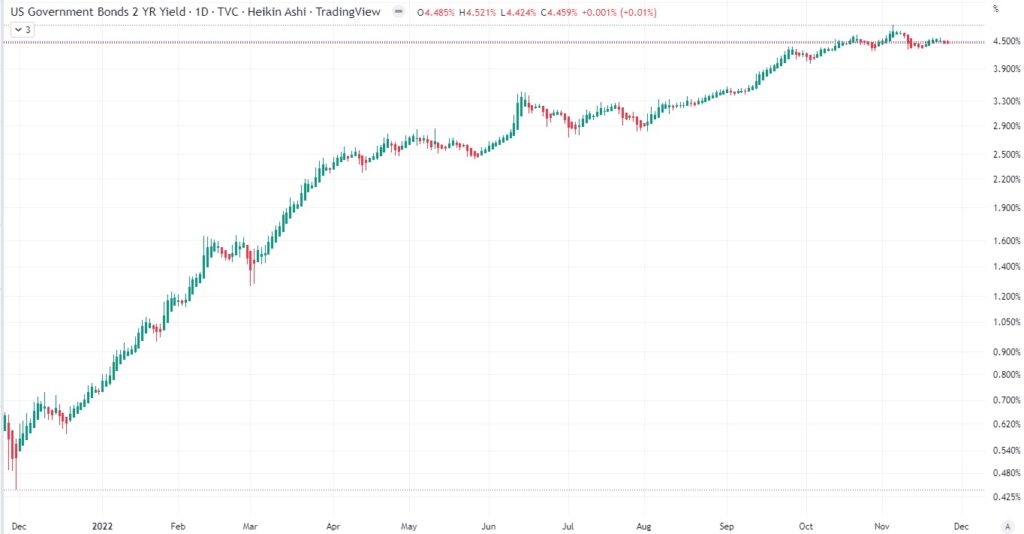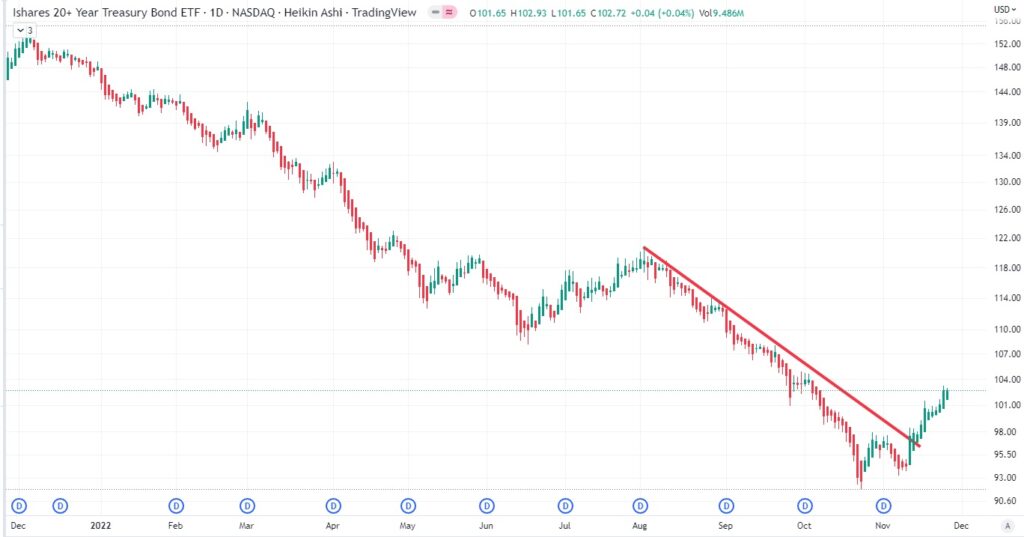As you know, the price of a bond is inversely correlated with interest rates. As interest rates go up, the price of a bond goes down. This makes sense.
If the face value of a bond is $10,000, and the interest rate paid by the bond is 10% of the face value, the bond pays $1,000 per year.
If market interest rates drop to 5%, and a new bond is issued with an interest rate of 5%, to earn that same $1,000 in interest, an investor would have to buy $20,000 worth of bonds.
But I own this bond with a fixed coupon of $1,000 per year. What will you pay me for it? The same $20,000. Interest rates dropped, so my bond is now worth more.
For the last year, interest rates have been going up:

The US Government 2 Year Bond yield was 0.44% on November 30, 2021, and a year later, on November 26, 2022, it’s at 4.467%.
That’s an increase of 10X, but that’s not my point. Here’s my point:
The Ishares 20+ Year Treasure Bond ETF, ticker symbol TLT on the Nasdaq, peaked at $154.91 on December 3, 2021, and collapsed down to $91.74 on October 24, 2022.

That’s a drop of over 40% in less than a year for a “safe, conservative” investment. Wow.
But this is exactly as we would expect. Interest rates went up, bonds are inversely correlated, so bonds went down.
Now for the important question: what’s next for interest rates?
If interest rates continue to increase, bonds will continue to drop. But, if interest rates have peaked or are close to peaking, bonds will start to run to the upside.
As the two charts above show, although interest rates have continued to increase, TLT stopped dropping in October and appears to have turned upwards. Why?
The obvious answer is that investors are forward-looking, so while interest rates are going up today, they expect that by tomorrow, next month, or next year, interest rates will turn lower, so now is the time to buy bonds to get in early.
Why Would Interest Rates Go Down?
Why did they go up? Inflation. Or, more specifically, central banks are raising interest rates to slow down the economy, to reduce inflation. Inflation is still “running hot,” so interest rates are rising.
I can’t predict the future, but my guess is that the Federal Reserve will raise interest rates again at their meeting in the middle of December. I also predict that a recession will be officially declared around March 2023. Once we are obviously in a recession, the economy no longer requires cooling, so interest rate hikes will pause. If the recession is severe, the Fed will lower interest rates to stimulate the economy, and the up and down cycle will continue.
So what’s your bet for 2023? Will we avoid a recession? If so, inflation will remain high, interest rates will stay high, so bonds will not be a good investment.
If that’s your opinion, the market disagrees with you, as clearly observed in the TLT chart. The market believes interest rates are peaking, and bonds will be the investment of 2023.
I agree.
The only question is: do I buy now, or wait until after the final Fed increase of the year in December?
The answer is to start accumulating a position now.
Everyone agrees that the Fed will raise rates in December, but their messaging will be more important. Do they say “we will continue to raise as long as inflation is increasing?” If so, at the first sign of inflation not increasing as fast, the market will expect lower interest rates in the future, and bonds will be the go-to investment of 2023.
TLT could be a great investment.
My plan is to dollar cost average in now, buying 20% of my desired position every week for the next five weeks. If there is a temporary drop at the next interest rate increase, great. If not, I keep buying.
If my average cost to buy TLT is under $110, and in a year TLT returns to $150, that’s a 36% profit. Not bad for a conservative investment.
But wait, there’s more! TLT pays a monthly dividend (a distribution of the interest earned on the bonds in the fund). On November 7, TLT paid .236 per share, so with TLT trading at $102.90 that’s an annual dividend rate of over 2.7%. If interest rates remain stable you earn the interest. If they fall, you get a capital gain.
This sounds like an excellent investment for the conservative portion of your portfolio. Do what you wish with this knowledge.
Thanks for reading; see you next week.
Time to Buy Bonds?
by JDH on November 26, 2022
As you know, the price of a bond is inversely correlated with interest rates. As interest rates go up, the price of a bond goes down. This makes sense.
If the face value of a bond is $10,000, and the interest rate paid by the bond is 10% of the face value, the bond pays $1,000 per year.
If market interest rates drop to 5%, and a new bond is issued with an interest rate of 5%, to earn that same $1,000 in interest, an investor would have to buy $20,000 worth of bonds.
But I own this bond with a fixed coupon of $1,000 per year. What will you pay me for it? The same $20,000. Interest rates dropped, so my bond is now worth more.
For the last year, interest rates have been going up:
The US Government 2 Year Bond yield was 0.44% on November 30, 2021, and a year later, on November 26, 2022, it’s at 4.467%.
That’s an increase of 10X, but that’s not my point. Here’s my point:
The Ishares 20+ Year Treasure Bond ETF, ticker symbol TLT on the Nasdaq, peaked at $154.91 on December 3, 2021, and collapsed down to $91.74 on October 24, 2022.
That’s a drop of over 40% in less than a year for a “safe, conservative” investment. Wow.
But this is exactly as we would expect. Interest rates went up, bonds are inversely correlated, so bonds went down.
Now for the important question: what’s next for interest rates?
If interest rates continue to increase, bonds will continue to drop. But, if interest rates have peaked or are close to peaking, bonds will start to run to the upside.
As the two charts above show, although interest rates have continued to increase, TLT stopped dropping in October and appears to have turned upwards. Why?
The obvious answer is that investors are forward-looking, so while interest rates are going up today, they expect that by tomorrow, next month, or next year, interest rates will turn lower, so now is the time to buy bonds to get in early.
Why Would Interest Rates Go Down?
Why did they go up? Inflation. Or, more specifically, central banks are raising interest rates to slow down the economy, to reduce inflation. Inflation is still “running hot,” so interest rates are rising.
I can’t predict the future, but my guess is that the Federal Reserve will raise interest rates again at their meeting in the middle of December. I also predict that a recession will be officially declared around March 2023. Once we are obviously in a recession, the economy no longer requires cooling, so interest rate hikes will pause. If the recession is severe, the Fed will lower interest rates to stimulate the economy, and the up and down cycle will continue.
So what’s your bet for 2023? Will we avoid a recession? If so, inflation will remain high, interest rates will stay high, so bonds will not be a good investment.
If that’s your opinion, the market disagrees with you, as clearly observed in the TLT chart. The market believes interest rates are peaking, and bonds will be the investment of 2023.
I agree.
The only question is: do I buy now, or wait until after the final Fed increase of the year in December?
The answer is to start accumulating a position now.
Everyone agrees that the Fed will raise rates in December, but their messaging will be more important. Do they say “we will continue to raise as long as inflation is increasing?” If so, at the first sign of inflation not increasing as fast, the market will expect lower interest rates in the future, and bonds will be the go-to investment of 2023.
TLT could be a great investment.
My plan is to dollar cost average in now, buying 20% of my desired position every week for the next five weeks. If there is a temporary drop at the next interest rate increase, great. If not, I keep buying.
If my average cost to buy TLT is under $110, and in a year TLT returns to $150, that’s a 36% profit. Not bad for a conservative investment.
But wait, there’s more! TLT pays a monthly dividend (a distribution of the interest earned on the bonds in the fund). On November 7, TLT paid .236 per share, so with TLT trading at $102.90 that’s an annual dividend rate of over 2.7%. If interest rates remain stable you earn the interest. If they fall, you get a capital gain.
This sounds like an excellent investment for the conservative portion of your portfolio. Do what you wish with this knowledge.
Thanks for reading; see you next week.